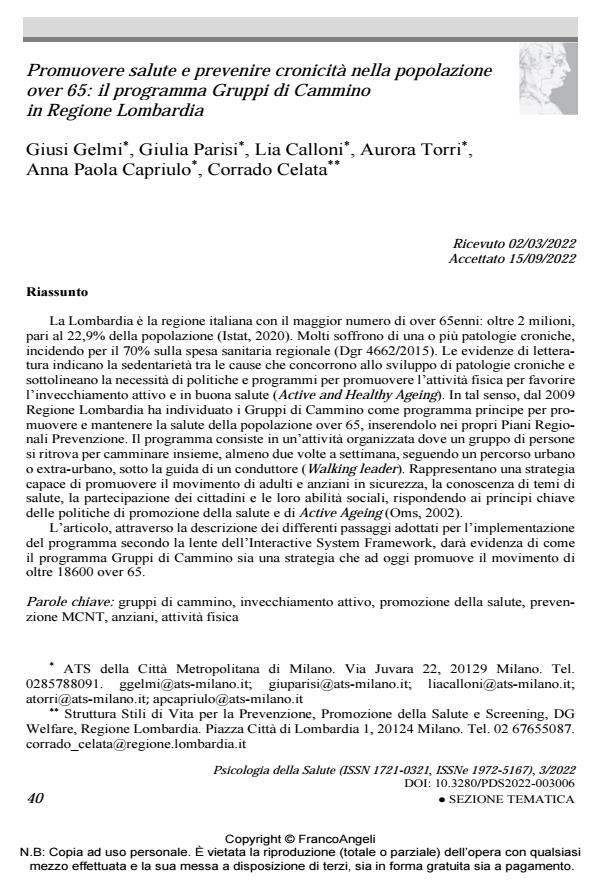Promuovere salute e prevenire cronicità nella popolazione over 65: il programma Gruppi di Cammino in Regione Lombardia
Journal title PSICOLOGIA DELLA SALUTE
Author/s Giusi Gelmi, Giulia Parisi, Lia Calloni, Aurora Torri, Anna Paola Capriulo, Corrado Celata
Publishing Year 2022 Issue 2022/3
Language Italian Pages 12 P. 40-51 File size 238 KB
DOI 10.3280/PDS2022-003006
DOI is like a bar code for intellectual property: to have more infomation
click here
Below, you can see the article first page
If you want to buy this article in PDF format, you can do it, following the instructions to buy download credits

FrancoAngeli is member of Publishers International Linking Association, Inc (PILA), a not-for-profit association which run the CrossRef service enabling links to and from online scholarly content.
Lombardy is the Italian region with the highest number of over 65s: over 2 million, equal to 22.9% of the total population (Istat, 2020). Many suffer from one or more chronic diseases, accounting for 70% of regional health expenditure (Dgr 4662/2015). The evidence indicates sedentary lifestyle among the causes that contribute to the development of chronic diseases and underlines the need for policies and programs to promote active and healthy aging (Active and Healthy Aging). In this sense, starting from 2009, Lombardy Region has identified Walking Groups as the main program to promote and maintain the health of the over 65 population, including them in its Regional Prevention Plans. The program consists of an organized activity where a group of people walk together, at least twice a week, following a safe urban or extra-urban path, under the guidance of a conductor (Walking leader). Therefore, Walking Groups represent a strategy capable of promoting movement of adults and the elderly in safety, knowledge of health issues and participation of citizens and their social skills, responding to the key principles of both health promotion and Active Aging policies (WHO, 2002). The article, through the description of the different steps adopted for the implementation of the program in Lombardy, according to the analysis lens of the Interactive System Framework, will highlight how the Walking Groups model is characterized as a strategy that today pro-motes the daily movement of over 18600 over 65.
Keywords: walking groups, active ageing, health promotion, NCD revention, older adults, physical activity
Giusi Gelmi, Giulia Parisi, Lia Calloni, Aurora Torri, Anna Paola Capriulo, Corrado Celata, Promuovere salute e prevenire cronicità nella popolazione over 65: il programma Gruppi di Cammino in Regione Lombardia in "PSICOLOGIA DELLA SALUTE" 3/2022, pp 40-51, DOI: 10.3280/PDS2022-003006